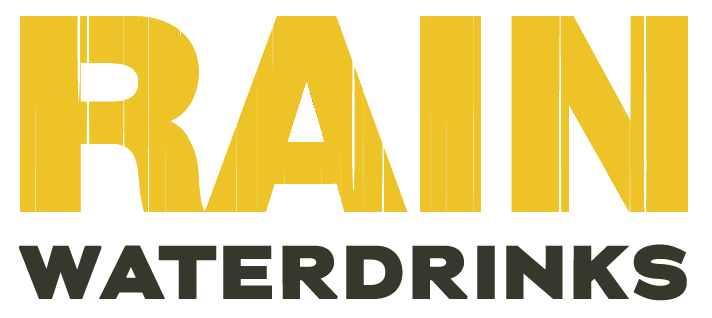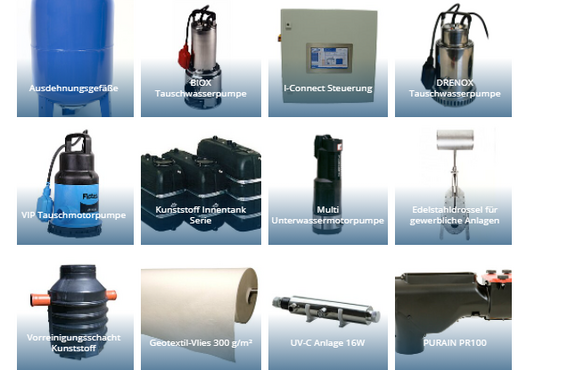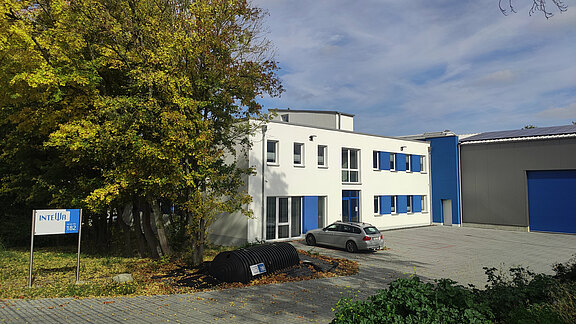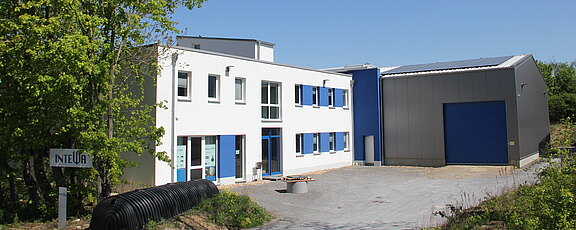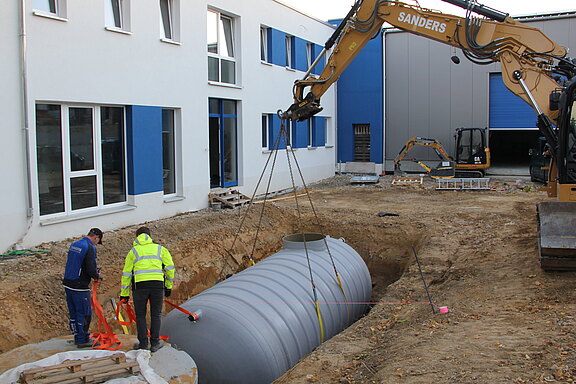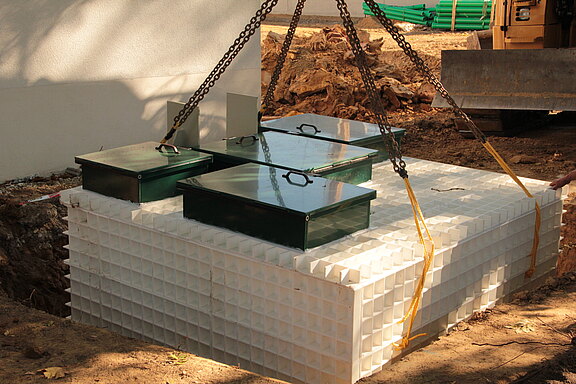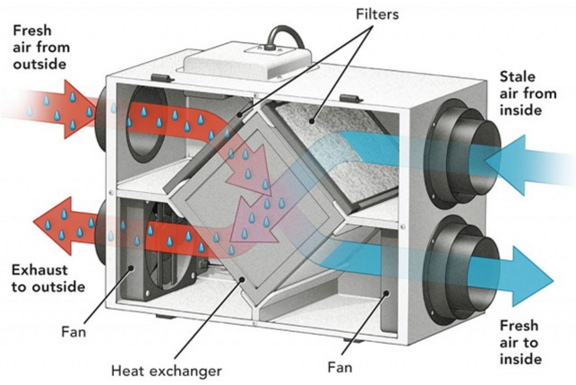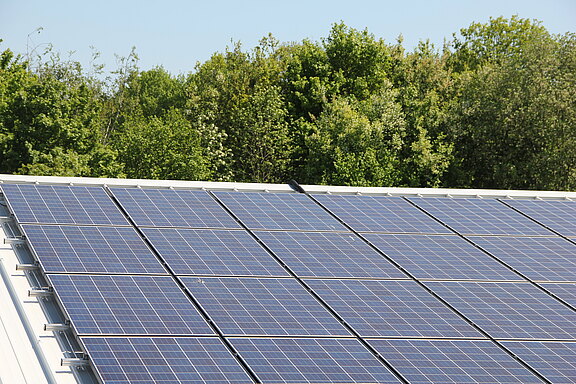Sustainable building: Energy-neutral, water self-sufficient and at the same time affordable?
How a company building from Aachen masters the balancing act between saving resources and profitability
Sustainability is an important topic for the construction and real estate industry. But how comprehensively and cost-effectively can these sustainability steps be implemented for energy and water neutrality? This is the exciting question that INTEWA, a company specialising in water technology, is addressing with its new company building in Aachen. The wide range of options currently available for the energy- and resource-saving design and operation of a company building is being tested here in practical implementation.
But INTEWA wants to go one step further. Because of the innovative building equipment installed in the company building, the internally produced grey water, small sewage treatment plant waste water and green roof waste water is additionally used for research purposes. Here, INTEWA will be test how the water treatment and reuse options can be further expanded in the future in order to continually optimise the resource-saving sustainability approach.
During the planning and implementation of the 2018 construction project, a wide range of measures were taken to create energy and water neutrality in the corporate context and thus create sustainability in a new dimension, which is made up of many individual technically and scientifically advanced measures
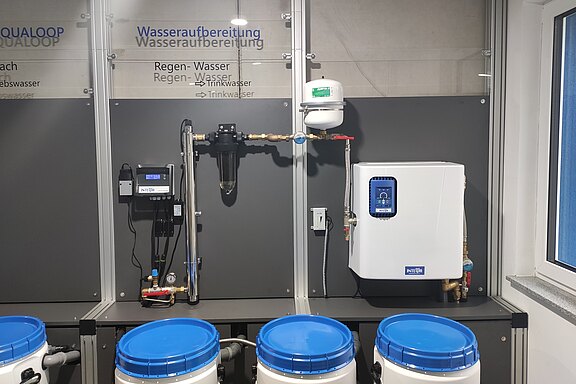
Water neutrality
In times of increasing water scarcity affecting people on all continents, the resource-saving use, treatment, purification and reuse of water has become a central element of sustainability in all areas of life. Last year, the World Economic Forum even declared water scarcity and its consequences as the greatest threat of the coming decade.
INTEWA uses a wide range of water treatment methods as well as rainwater utilisation and retention to create water neutrality in the new company building and to make optimum use of natural water and energy sources.
Here, rainwater serves as the main and drinking water source. Around 380 m³ of rainwater is collected annually from the company's roof and fed into a 30m³ food-grade fibreglass storage tank to be treated to drinking water quality using the AQUALOOP technology developed by INTEWA. Water quality is regularly checked and certified by a recognised laboratory.
This commercial use of treated potable rainwater for the company's kitchen, hand basins, and dishwashers, is unique in Germany. The fibreglass cistern also serves as a retention tank for heavy rainfall events.
Another source of water - in this case for non-potable process water - is small wastewater treatment plant using AQUALOOP technology, which is used with a RAINMASTER Eco in piping for flushing toilets. This water recycling process supplies 66m³ of water annually for toilet flushing. From an economic point of view, this water cycle is doubly efficient, as both drinking water and wastewater costs are saved. This resource-saving approach is also highly innovative.
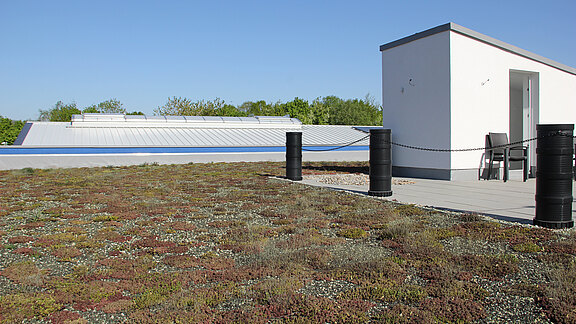
The 300 m² green roof, which was laid out on a portion of the building, has many benefits. The run-off water, amounts to about 168 m³ annually, allows research by the INTEWA team into improved green roof runoff treatment techniques. This is done all while using the captured water for irrigation.
In addition, the green roof serves to optimise the building insulation and to regulate the natural climate. By means of the evaporation of the rainwater retained by the green roof, a cooling effect of the building is achieved. At 680 kWh/m³ evaporation cooling, 117,600 kWh cooling capacity is created here to improve the microclimate. This in turn contributes to the energy neutrality of the company building. In addition to the increase in biodiversity, the improvement in air quality and the reduction of peak runoff during rainfall events are further positive aspects of the green roof.
The permeable traffic areas that were built on the company premises allow for a natural, decentralised infiltration. In addition to the preservation of the fertile soil layer and the vegetative ability, the infiltration and eliminated runoff recharges the groundwater As excessive impermeable surfaces from increase building, parking, and roads upsets the natural water balance, the Federal Environment Agency indicates that increased permeable surfaces helps restore this balance. From a financial point of view, the savings in recharging precipitation to the groundwater has a positive return.
Energy neutrality
INTEWA is an innovative company that relies on the latest technical solutions and progressive, diverse measures to save energy in its heaquarter building.
INTEWA reduces energy costs by 50% by using two 800m³/h ventilation systems with heat recovery as enthalpy heat exchangers. Both temperature and humidity are transferred to ensure a pleasant indoor climate. This system ensures both cooling of the warm outside air in summer and warming of the cold outside air in winter.
The required electrical energy is generated by the photovoltaic (PV) solar system, which is placed on the roof of the building in an east-west orientation, in order to cover the daily requirements as optimally as possible. Due to efficient dimensioning, the photovoltaic system produces all required annual energy of the company of around 16,000 kWh and guaranteeing energy neutrality.
A very efficient water heat pump draws the energy for heating in winter and also as a circulation pump for cooling in summer from the ground. By means of two geothermal probes, which were placed at a depth of 100m by means of deep drilling, heat is extracted from the ground, which is passed on to the heat pump and thus generates a heating output of 13.21kW.
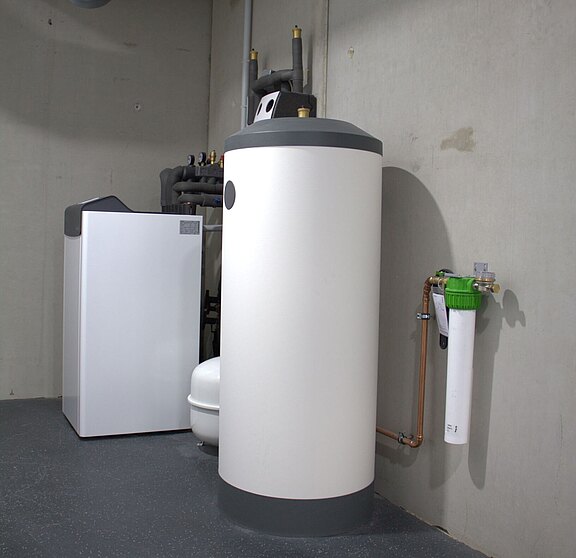
This heat is used to operate the energy-saving low-temperature sub-floor heating. Hot water for the hand basins is produced by means of small flow heaters. In case of high outside temperatures, the circulation pump in cooling mode ensures a temperature reduction within the building via the underfloor heating.
A building automation system used to further optimise energy consumption. It controls the energy-saving LED lighting in and around the building according to demand and can also regulate the building temperature and the respective heating and cooling capacity to achieve maximum efficiency. Brightness, motion, and temperature are detected via multi-sensors. This enables the energy consumption to be adjusted to the actual demand. In practice, this means that if no motion is measured in parts of an open-plan office for an adjustable period of time, the lighting in the relevant area of the room is automatically switched off until the presence of a person is measured again via the motion sensors. This reduces energy consumption.
The connected components can also be monitored and remotely controlled via PC or app. This also promotes demand-oriented and simple adjustment and thus optimisation of the actual energy consumption.
Conclusion
INTEWA have taken the opportunity to showcase a number of innovative sustainability possibilities to achieve net-zero energy and water consumption in their new headquarters building. All steps taken complement each other to achieve a sound financial return.
From the treatment and use of rainwater, to the purification and recycling of water from the wastewater plant, to the replenishment of groundwater through the use of permeable traffic areas, the resource water is used economically, ecologically, and effectively. The company building is thus independent of a central water supply and generates its own commercial demand by means of the water treatment technology developed in-house, which is also being further developed.
The company building achieves energy neutrality by means of a very low requirement through the use of a ventilation system with heat recovery, the optimised external insulation e.g. through the green roof, and the low-temperature underfloor heating as well as the use of heat from the ground. This low consumption can be guaranteed by the optimised own energy generation by means of the efficiently dimensioned photovoltaic system and thus ensures energy neutrality.
The approach to construct a commercial building in such a way that both water and energy requirements are generated autonomously is sensible, profitable, and forward-looking. INTEWA in Aachen provides practical proof of the feasibility of this comprehensive sustainability approach with the new company building.
INTEWA GmbH
Auf der Hüls 182
D-52068 Aachen
Phone: +49 (0) 241-96605-0
Author: Daniela Johanna Voigt
Characters: 8.570 incl. spaces
Further information on INTEWA construction can be found on: https://building.intewa.net/
Note:
Modifications of the article are only allowed with the explicit permission from the author!

